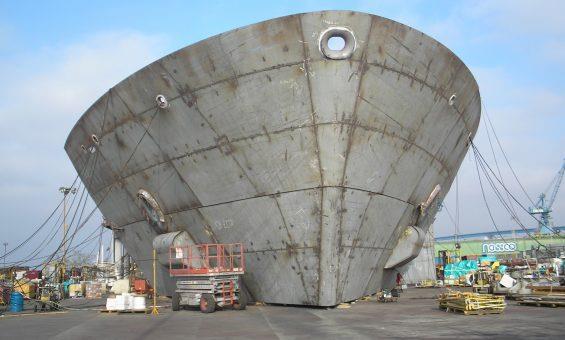
International Research Journal of Engineering and Technology (IRJET) e-ISSN:2395-0056
Volume: 11 Issue: 09 | Sep 2024 www.irjet.net p-ISSN:2395-0072


International Research Journal of Engineering and Technology (IRJET) e-ISSN:2395-0056
Volume: 11 Issue: 09 | Sep 2024 www.irjet.net p-ISSN:2395-0072
Akilan Sukumara Selvan1, Abiyuth Anthoni Samy2, Mariappan A C3, Peter Packiaraj4
1,2Final Year B.E Marine Cadets, PSN CET, Tirunelveli, Tamil Nadu 3,4Assistant Professor, Dept. Of Marine Engineering, PSN CET, Tirunelveli, Tamil Nadu
Abstract -The use of lightweight and high-strength materials in shipbuilding is revolutionizing the industry by improving fuel efficiency, increasing cargo capacity, and enhancing vessel performance. These materials, including advanced composites, aluminum alloys, and high-strength steels, reduce the overall weight of ships while maintaining structural integrity. This results in lower operational costs, better maneuverability, and reduced environmental impact. By adopting these materials, modern ships achieve greater efficiency, durability, and sustainability in maritime operations.
The use of 5083 aluminum alloy in ship building has revolutionized the design and construction of modern vessels
This aluminum alloy is particularly valued for its excellent mechanical properties, including high strength-to weightratio and good weldability. It is an ideal choice for constructing light weight like durable ship hulls, and other critical components.
Key Words: Hull Material Upgrade, Weight Reduction, Corrosion Resistance, Fuel Efficiency, Structural Integrity, Material Substitution, Longevity and Maintenance,PerformanceImprovement.
1.1Fuel Efficiency
Fuel efficiency is a critical factor in ship design and operation, directly influencing operating costs and environmental impact. The use of lightweight and highstrength materials, particularly 5083 aluminum alloy, plays a significant role in enhancing fuel efficiency in modern vessels. Due to its excellent strength-to-weight ratio, 5083 aluminum allows for significant weight reductions in ship structures without compromising structuralintegrity.
By reducing the overall weight of a ship, less power is required to propel the vessel through the water, leading to lower fuel consumption and emissions. This is particularly beneficial for high-speed vessels, where weight reduction has a more pronounced effect on
performance.Moreover,thecorrosionresistanceof5083 aluminum alloy extends the lifespan of the ship's hull, reducing the need for maintenance and repairs, which further contributes to operational efficiency and sustainability.
Inshipbuilding,optimizingcargocapacityisessentialfor maximizing operational efficiency and profitability. The use of lightweight and high-strength materials, such as 5083 aluminum alloy, significantly contributes to increasingaship'scargocapacity.Thisaluminumalloyis renowned for its high strength-to-weight ratio, which allows for substantial weight reduction in the ship's structurewithoutsacrificingdurabilityorsafety
By utilizing 5083 aluminum alloy, the overall weight of the vessel is reduced, freeing up additional capacity that canbeallocatedtocargoratherthantheship’sstructure. This increase in cargo capacity directly translates to higher revenue potential per voyage, as more goods can be transported without exceeding the vessel's design limits. Furthermore, the reduced weight also enhances fuelefficiency,allowingtheshiptocarrymorecargowith the same fuel expenditure, thus lowering per-unit transportationcosts.
The use of 5083 aluminum alloy results in significant weight reductions, which in turn improve the ship’s speed, maneuverability, and fuel efficiency. A lighter vessel requires less energy to achieve higher speeds, which is crucial for applications such as high-speed ferries, patrol boats, and racing yachts. Additionally, the alloy’s resistance to marine corrosion ensures long-term structural integrity, reducing maintenance needs and extendingthevessel'soperationallifespan.
Moreover,theenhancedperformancegainedthroughthe useof5083aluminumalloyallowsshipstooperatemore efficientlyinvariousseaconditions,improvingsafetyand reliability. This material also enables designers to innovate with advanced hull forms and structures, further optimizing performance characteristics like stability,hydrodynamics,andloaddistribution.

International Research Journal of Engineering and Technology (IRJET) e-ISSN:2395-0056
Volume: 11 Issue: 09 | Sep 2024 www.irjet.net p-ISSN:2395-0072
By enabling significant weight reductions, 5083 aluminum alloy helps improve fuel efficiency, leading to lower greenhouse gas emissions and reduced fuel consumption. This is particularly important in the context of the global maritime industry’s efforts to minimize its environmental impact and comply with stricteremissionsregulations.
Moreover, 5083 aluminum alloy is highly recyclable, whichreducesthedemandforrawmaterialsand energy intensive processes associated with the production of new materials. At the end of a ship's life, the aluminum components can be recycled with minimal energy input, significantly lowering the environmental impact comparedtotraditionalshipmaterialslikesteel.
Reduced weight is a key factor in increasing a ship's speed. With less mass to propel through the water, engines can achieve higher speeds more efficiently, whichisespeciallybeneficialforhighspeedferries,patrol boats,andracingyachts.Thereduceddragandimproved hydrodynamics resulting from the lighter structure further contribute to increased speed capabilities. In addition to speed, maneuverability is also enhanced by the use of 5083 aluminum alloy.Alighter vessel is more responsive to steering inputs, allowing for quicker turns and better handling in tight or challenging conditions. This is particularly advantageous in operations that require precise navigation, such as in coastal waters, harbors, or during search and rescue missions. The improved agility also enhances safety, as the vessel can more effectively avoid obstacles and respond to sudden changesinseaconditions.
One of the primary maintenance benefits of using 5083 aluminumalloyisitsresistancetocorrosion,particularly from saltwater exposure, which is a common issue in maritimeoperations.Thisresistanceminimizestheneed for frequent repainting, anti-corrosion treatments, and repairs, thereby reducing downtime and maintenance costs.
The alloy's ability to withstand stress and fatigue over long periods also means that structural components are lesslikelytosufferfromcrackingordeformation,further extending the intervals between necessary maintenance activities Additionally, the use of this alloy simplifies repair processes. Its weldability ensures that when repairsareneeded,theycanbeperformedefficientlyand effectively,oftenwithouttheneedforspecializedtoolsor techniques. The overall durability and longevity of 5083 aluminum alloy contribute to a longer service life for
vessels,withfewerdisruptionsformaintenance,thereby enhancingoperationalavailabilityandcosteffectiveness.
5083 aluminum alloy is a high-strength, non-heattreatable alloy primarily composed of magnesium and traces of manganese and chromium. It is known for its exceptional resistance to corrosion, particularly in marine environments, making it a popular choice for shipbuilding and other applications where exposure to saltwateriscommon
The chemical composition of 5083 aluminum alloy is characterizedbythefollowingelements
Magnesium(Mg): 4.0–4.9%
Manganese(Mn): 0.4–1.0%
Chromium(Cr): 0.05–0.25%
Silicon(Si): ≤0.4%
Iron(Fe): ≤0.4%
Copper(Cu): ≤0.1%
Zinc(Zn): ≤0.25%
Titanium(Ti): ≤0.15%
Others(each): ≤0.05%
Others(total): ≤0.15%
Aluminum(Al): Balance


International Research Journal of Engineering and Technology (IRJET) e-ISSN:2395-0056
Volume: 11 Issue: 09 | Sep 2024 www.irjet.net p-ISSN:2395-0072
3. Comparison of Aluminum Alloy vs HSLA (High Strength Low Alloy) Steel Used for Ship Hull

Chart-1 : AL5083 Vs HSLA steel
Strength-to-Weight Ratio
Aluminum alloys have a higher strength-to-weight ratio compared to steel, meaning they provide similar strengthatalighterweight.
Corrosion Resistance
Aluminum Alloys Naturally forms a protective oxide layer that provides good corrosion resistance in marine environments.
Cost
Aluminum Alloys: Typically, more expensive per kilogramthansteel.
Steel: Generally, less expensive and widely available comparedtoaluminumalloys.
Maintenance
Aluminum Alloys: Easier to machine and weld than steel.
Steel: More challenging to weld and machine comparedtoaluminum.
4. Difference Between Aluminum Alloy & HSLA
Property HSLA Steel (e.g.,AH36)
AluminumAlloy(e.g., 5083)
Tensile Strength 355 Mpa (typical) 320Mpa(typical)
Yield Strength 245 Mpa (Minimum) 250Mpa (typical)
Density 7850kg/m3 2700kg/m3
Weight Reduction - Significant due to lowerdensity
Corrosion Resistance Moderate (requires coating) Excellent (natural oxidelayer)
Weldability High High
Coat Lower Higher
Table : 1
4.1 Weight
AluminumAlloy5083 :Muchlighterthansteel,offering significantweightsavings.
HSLASteel :Heavierthanaluminum,leadingto aheavieroverallvessel.
4.2 Strength
AluminumAlloy5083 :Strong,butnotashighintensile strengthasHSLAsteel.
HSLASteel :Highertensilestrength,makingit suitableforhigh-stressconditions.
4.3 Corrosion Resistance
Aluminum Alloy 5083: Excellent corrosion resistance, particularlyinmarineenvironments.
HSLA Steel: Requires coatings and more maintenance to preventcorrosioninsaltwater.
4.4 Weldability
Aluminum Alloy 5083: Highly weldable but requires carefultechniquetoavoiddefects.
HSLA Steel: Good weldability with well-established methods,butcaninducemoreresidualstress.
4.5 Cost
Aluminum Alloy 5083: More expensive initially but may lead to lower long-term operational costs due to weight savings.
HSLA Steel: Less expensive in material cost, but heavier andrequiresmoremaintenance.
4.6 Fatigue and Impact Resistance
Aluminum Alloy 5083: Good fatigue resistance but less impact-resistantthansteel.
HSLA Steel: Superior impact and fatigue resistance, makingitdurableundercyclicloads.
5. Strength & Structural Integrity
HSLASteel(AH36):
1. Tensilestrength:355Map
2. Yieldstrength :245Mpa.
Aluminum5083:
1. Tensilestrength:330Map
2. Yieldstrength :275Mpa.


International Research Journal of Engineering and Technology (IRJET) e-ISSN:2395-0056
Volume: 11 Issue: 09 | Sep 2024 www.irjet.net
5.1 Tensile Strength
HSLASteel(AH36):355MPa Aluminum5083:330MPa
Implication : HSLA steel has slightly higher tensile strength,meaningitcanhandleabitmoreforcebeforeit starts to stretch and eventually break. This makes it bettersuitedforapplicationswherethematerialisunder heavyloadsorstress.
5.2 Yield Strength
HSLASteel(AH36):245MPa Alumim5083:275MPa
Implication : Aluminum 5083 actually has a higher yield strength, meaning it can withstand more stress before it begins to deform permanently. This is beneficial in applicationswheremaintainingtheoriginalshapeunder stressiscritical.
6. Conclusion
Aluminum 5083 is much lighter than steel, makingtheshipfasterandmorefuel-efficient.
It resists rust very well, especially in saltwater, which means less maintenance and a longerlastinghull.
Despite being lighter, Aluminum 5083 is strong enough to handle the stresses of marine environments.
While aluminum might cost more upfront, it savesmoneyovertimewithbetterfuelefficiency andlowermaintenancecosts.
Using lighter aluminum reduces fuel consumption, leading to fewer emissions and a smallerenvironmentalfootprint.
References
[1] Parker, J. D. (2015). Aluminum Alloys for Marine Applications. Journal of Marine Engineering, 28(1), 4560.Availableat:ScienceDirectLiu,H.,
[2] Zhang, Y. (2017). Lightweight Materials in Shipbuilding: Benefits and Challenges. Marine Technology and Engineering, 33(4), 210-225. Available at:Taylor&FrancisOnline
[3] Kim,H.J.,&Lee,S.K.AddStructuralReinforcements (2019). Evaluation of Aluminum Alloy 5083 for Marine Hulls: A Comparative Study with Traditional Steel. Ship Technology Research, 66(3), 178-189. Available at: SpringerLink
[4] Nielsen, J. C., & Anderson, T. (2020). Performance Improvements in High-Speed Ferries Using Aluminum Hulls.JournalofShipResearch,64(2),115-128.Available at:SAGEJournals
p-ISSN:2395-0072
[5]Brown,C.L., &Patel,R. (2018).Corrosion Resistance of Aluminum Alloys in Marine Environments: A Review. Corrosion Science, 144, 170-185. Available at: ScienceDirect
Biographies




IampursuingB.EfinalyearMarine EngineeringcadetatPSNCollegeof Engineering & Technology, Tirunelveli,TamilNadu
I ampursuingB.EfinalyearMarine EngineeringcadetatPSNCollegeof Engineering & Technology, Tirunelveli,TamilNadu.
Guide cum Assistant Professor PSN College of Engineering & Technology, Tirunelveli, Tamil Nadu. Also having 15 years’ experience in Oil and Gas industries. Specialization in NDT andworkedvariesGulf Countries.
Project Guide cum Assistant Professor PSN College of Engineering & Technology, Tirunelveli,TamilNadu.MEOClassIV Marine Engineer and worked variesCountries.